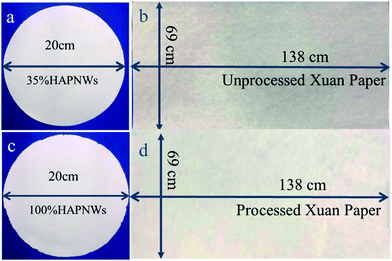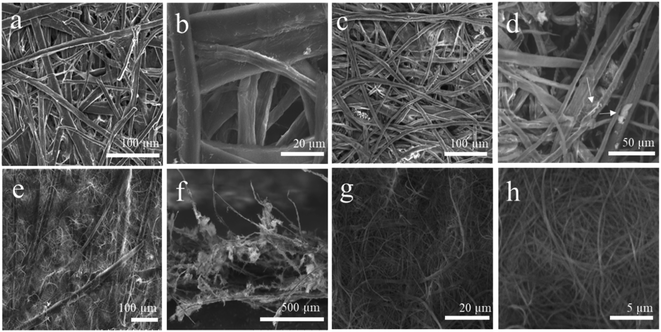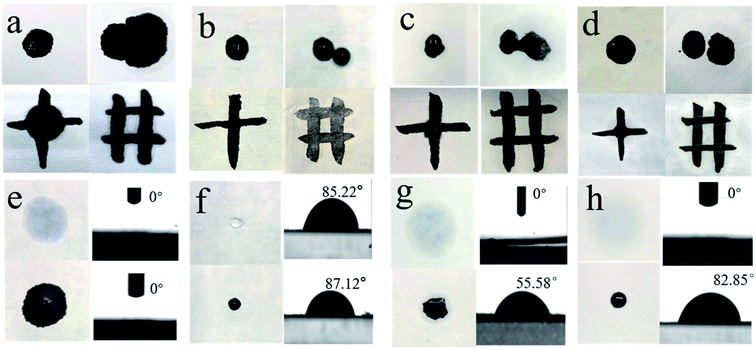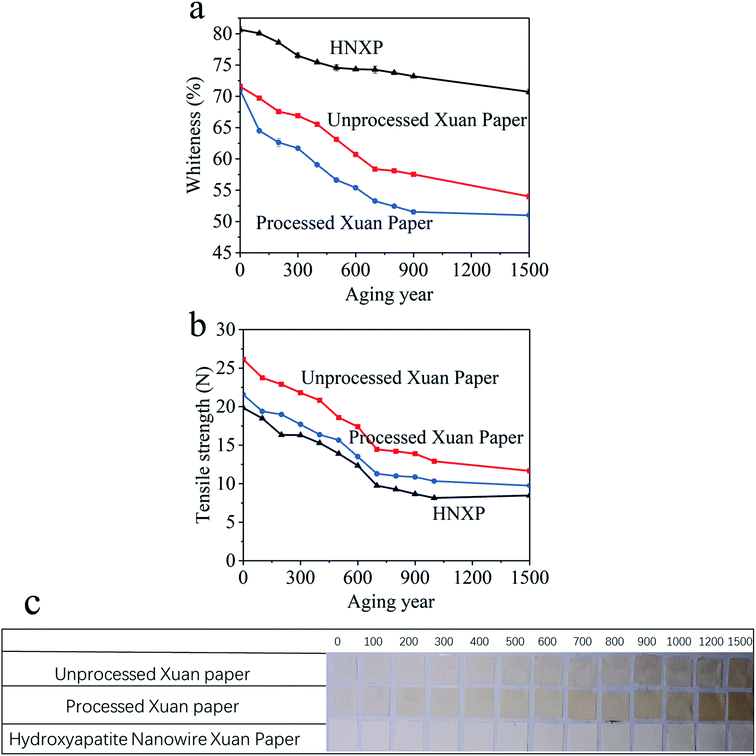 Open Access Article
Open Access ArticleA new kind of nanocomposite Xuan paper comprising ultralong hydroxyapatite nanowires and cellulose fibers with a unique ink wetting performance†
Yue-Ting Shaoab,
Ying-Jie Zhu *ab,
Li-Ying Dong*a and
Qiang-Qiang Zhangab
*ab,
Li-Ying Dong*a and
Qiang-Qiang Zhangab
aState Key Laboratory of High Performance Ceramics and Superfine Microstructure, Shanghai Institute of Ceramics, Chinese Academy of Sciences, 1295 Dingxi Road, Shanghai 200050, P. R. China. E-mail: y.j.zhu@mail.sic.ac.cn; lydong@mail.sic.ac.cn
bCenter of Materials Science and Optoelectronics Engineering, University of Chinese Academy of Sciences, Beijing 100049, P. R. China
First published on 9th December 2019
Abstract
In the history of civilization, Xuan paper with its superior texture, durability and suitable characteristics for writing and painting, has played an important role in the dissemination of culture and art. Xuan paper has won the reputation of “the king of paper that lasts for 1000 years” and was inscribed on the Representative List of the Intangible Cultural Heritage of Humanity by the Educational, Scientific and Cultural Organization of the United Nations in 2009. However, the surface of the commercial unprocessed Xuan paper has a large number of large-sized pores with a poor resistance to water, allowing ink droplets to easily spread during the writing and painting process. In this study, we report a new kind of nanocomposite Xuan (HNXP) paper comprising ultralong hydroxyapatite (HAP) nanowires and plant cellulose fibers with unique ink wetting performance, high whiteness and excellent durability. The as-prepared HNXP paper sheets with various weight ratios of ultralong HAP nanowires ranging from 10% to 100% are all superhydrophilic with a water contact angle of zero. In contrast, the ink contact angle of the HNXP paper can be well controlled by adjusting the weight ratio of ultralong HAP nanowires, and the ink contact angle of the HNXP paper increases with increasing weight ratio of ultralong HAP nanowires. The experimental results show the unique ink wetting behavior of the as-prepared HNXP paper, which is absent in the traditional Xuan paper. This new kind of nanocomposite Xuan paper comprising ultralong hydroxyapatite nanowires and plant cellulose fibers is promising for applications in calligraphy and painting arts.
1. Introduction
Paper is one of the most essential materials in the world. The emergence of paper provided an important foundation for the dissemination of culture, art and science. Xuan paper is famous for its durability and unique ink wetting properties, it has been called the “the king of paper that lasts for 1000 years”, and it has played a unique role in the history of painting and calligraphy, especially in China. The traditional handicraft of making Xuan paper was inscribed on the Representative List of the Intangible Cultural Heritage of Humanity by the Educational, Scientific and Cultural Organization of the United Nations in 2009. Xuan paper was already a tribute of the Xuanzhou Prefecture in the Tang Dynasty in China. The raw materials used in the production of Xuan paper are the bark of pteroceltis tatarinowii and Shatian straw, and both of them only grow in Jing County, Anhui Province in China.1 The hydrophilicity of plant fibers and porosity of the interior structure cause Xuan paper to have strong water absorption and ink absorption properties.In ancient times, people wrote on the unprocessed Xuan paper directly using a writing brush, and the Xuan paper was easily moisturized by water, leading to blurred strokes.2 In order to improve the ink wetting effect, the surface sizing techniques of paper evolved.3 One of the traditional ways was to apply gelatin and alum on the surface of the unprocessed Xuan paper to obtain the resistance to ink.4 However, alum could hydrolyze easily, which made the traditional processed Xuan paper hydrolyze and also made the ancient paintings difficult to preserve for a long time,5 resulting in irreparable loss of human culture and art. In addition, the output of the commercial Xuan paper is low, and the production cost is high due to the insufficient supply of raw materials and more than 100 handcraft production processes.
Herein, we report a new kind of nanocomposite Xuan (HNXP) paper comprising ultralong hydroxyapatite nanowires and plant cellulose fibers with unique ink wetting performance, high whiteness and excellent durability. The HNXP paper is made from ultralong hydroxyapatite (HAP, Ca10(OH)2(PO4)6) nanowires6 and unprocessed Xuan paper pulp. The as-prepared HNXP paper sheets with various weight ratios of ultralong HAP nanowires ranging from 10% to 100% are all superhydrophilic with a water contact angle of zero. In contrast, the ink contact angle of the HNXP paper can be well controlled by adjusting the weight ratio of ultralong HAP nanowires, and the ink contact angle of the HNXP paper increases with increasing weight ratio of ultralong HAP nanowires. The ink wetting behavior of the as-prepared HNXP paper is unique, which is absent in the traditional Xuan paper.
HAP, the main inorganic component of teeth and bones of vertebrates, has excellent biological properties including non-toxicity, high biocompatibility, good bone defect repair performance.7–12 The properties and applications of HAP materials are influenced by many factors such as morphology, size and crystallinity.13,14 The Zhu research group has successfully synthesized ultralong HAP nanowires with diameters of ∼10 nm and lengths up to several hundred micrometers by the calcium oleate precursor solvothermal/hydrothermal method.15–18 Ultralong HAP nanowires can be used to make a new kind of high-strength fire-resistant inorganic paper with high flexibility.15,19,20 Recently, this research group reported a new kind of highly flexible fire-resistant inorganic analogous Xuan paper composed of ultralong HAP nanowires, inorganic fibers and inorganic adhesive, it has thousands of years' superdurability, unique ink wetting, high whiteness, and excellent antimildew benefiting from its 100% inorganic origin, and these merits are far superior over the traditional Xuan paper.19 The most attractive advantages of the inorganic analogous Xuan paper are its excellent fire resistance and high thermal stability, which can well safeguard precious calligraphy and painting works, documents, and books for a very long period of time without the fear of being destroyed by fire or yellowing. However, the control over the ink wetting performance and detailed ink wetting mechanism of the fire-resistant inorganic analogous Xuan paper have not been investigated.19
Ultralong HAP nanowires can interweave with each other to form the porous networked structure, and its pore sizes are smaller than those formed by plant cellulose fibers. When ultralong HAP nanowires are added proportionally into the commercial Xuan paper pulp, the ink wetting performance of the HNXP paper can be adjusted. Unlike the traditional surface sizing, whose ink resistance mechanism is based on the hydrophobic property, the as-prepared HNXP paper is hydrophilic but has a large ink contact angle. In addition, the durability, yellowing and degradation of the commercial Xuan paper can be improved by the addition of ultralong HAP nanowires. Therefore, this new kind of nanocomposite Xuan paper comprising ultralong HAP nanowires and plant cellulose fibers is promising for the application in calligraphy and painting arts.
2. Experimental section
Materials
Calcium chloride (CaCl2), sodium dihydrogen phosphate dihydrate (NaH2PO4·2H2O) were purchased from Sinopharm Chemical Reagent Co. Ltd. Unprocessed Xuan paper and processed Xuan paper were purchased commercially. Ink was obtained from Beijing Yidege Ink Co. Ltd. Deionized water was used in all experiments.Preparation of ultralong HAP nanowires
Ultralong HAP nanowires were prepared by the calcium oleate precursor hydrothermal method previously reported by this research group.21 Briefly, sodium oleate (400.0 g) was dissolved in deionized water (4 L) and stirred, and an aqueous solution (1.5 L) containing CaCl2 (44.0 g) was added to the above solution and stirred. Then an aqueous solution (1.5 L) containing NaH2PO4·2H2O (56.0 g) was added to the above suspension under stirring. Finally, the reaction mixture was transferred into a stainless steel autoclave with a volume of 10 L, sealed, and heated at 200 °C for 36 h. The product was washed with ethanol and deionized water three times, respectively.Preparation of the nanocomposite Xuan (HNXP) paper
The commercial unprocessed Xuan paper was put into the beater to be treated for 30 min till there were no large floccules in the pulp, and was treated in an ultrasonic instrument for 15 min. Then, an aqueous suspension containing ultralong HAP nanowires was added into the aqueous suspension of unprocessed Xuan paper pulp. The HNXP paper was prepared by filtering the above aqueous suspension using a papermaking machine with the assistance of vacuum to form a wet paper, and the obtained wet paper was pressed at a pressure of 4 MPa and dried at 105 °C for 3 min.The as-prepared HNXP samples were pretreated in an environment with a relative humidity of 50% ± 2% at a temperature of (23 ± 1) °C. The paper pretreatment ended when two weighing difference between 1 h interval is smaller than 0.25% of the total mass.22
Ink wetting performance
One important criterion for distinguishing the quality of the Xuan paper is the display status of the ink, which is the so-called the ink wetting property.23 This kind of performance refers to the peripheral symmetry of ink diffusion on the paper, including the penetration of ink, adsorption strength, color shade of ink, degree of clarity, and the ability to resist ink.The ink wetting tests were performed according to the national standard GB/T 18739-2008 “Product of geographical indication-Xuan paper”. Took a 20 mm × 20 mm HNXP sample, laid it flat on a blanket, and a drop of thick ink and a drop of light ink were dropped at different places on the HNXP paper. When the ink was not spread on the paper surface, a drop of light ink was dropped on the edge of a thick ink droplet. Each time a drop of ink with the same volume was dropped onto the paper from the same height of 50 mm. When the ink was dropped on the paper, a digital camera was used to record the dispersion of the ink. A pattern shaped like “+” was written using a writing brush containing the thick ink on a droplet of light ink. In addition, a pattern shaped like “#” was written using a writing brush containing the light ink on the HNXP paper.
Durability evaluation
Durability of the paper refers to the ability of the paper to maintain its chemical stability and initial properties over a long period of time. In order to predict the durability of the paper, the artificial accelerated aging method is usually adopted.24 In this work, the Standards of the Technical Association of the Pulp and Paper Industry of USA (TAPPI) was adopted for the durability evaluation. The HNXP paper was placed in a heating oven at (105 ± 0.5) °C, and heating for 3 days (72 h) is equivalent to aging the paper for 25 years under natural conditions.25Characterization of the HNXP samples
The HNXP samples were characterized by field-emission scanning electron microscopy (SEM, Hitachi S-4800, Japan), X-ray diffraction (XRD, Cu Kα radiation, λ = 1.54178 Å, Rigaku D/max 2550V, Japan), Fourier transform infrared (FTIR) spectroscopy (FTIR-7600, Lambda Scientific, Australia). Contact angle tests were performed using an automatic contact angle meter (Model SL200B, USA). The pore size and pore size distribution of the HNXP paper were measured with an automatic mercury porosimeter (AutoPore IV 9510, Micromeritics, USA). The tensile strength and whiteness tests of the HNXP paper were conducted according to the GB/T18739-2008 standards. To ensure the data repeatability, at least three parallel tests were carried out for each measurement.3. Results and discussion
Characterization of samples
Digital images of the as-prepared HNXP paper, pure HAP nanowire paper and commercial Xuan paper are shown in Fig. 1. Both the HNXP paper and pure HAP nanowire paper exhibit a uniform white color with a diameter of 20 cm. It shows that both the HNXP paper and pure HAP nanowire paper have a higher whiteness than those of the commercial unprocessed Xuan paper and processed Xuan paper.The SEM images (Fig. 2a–d) illustrate that the commercial unprocessed Xuan paper and processed Xuan paper have a porous structure formed by interweaving plant fibers. The diameters of plant fibers range from several to 20 microns. The SEM images of the commercial unprocessed Xuan paper show that the plant fibers form a loose and porous microstructure, and the plant fibers are interlaced and there are large pores among them (Fig. 2a and b).26,27 Fig. 2c and d indicates that an adhesive film and some particles adhere to the plant fibers of the processed Xuan paper, because the processed Xuan paper is treated by the surface sizing with gelatin and alum solution. The alum can absorb water in the air and act as a bridge to combine a plurality of anionic constituents onto the fiber surface.
From the SEM images (Fig. 2e and f) of the as-prepared HNXP paper, one can see that ultralong HAP nanowires are evenly distributed in the pores of plant fibers or wrap around plant fibers. The as-prepared ultralong HAP nanowires (Fig. 2g and h) have diameters of about 10 nm and lengths up to hundreds of micrometers, and HAP nanowires self-assemble along the longitudinal direction to form HAP nanowire bundles in many cases.
The FTIR spectra of the HNXP paper and commercial Xuan paper are shown in Fig. 3a, the broad peak at around 3465 cm−1 is assigned to the adsorbed water in the HNXP paper, HAP nanowires and commercial Xuan paper. The absorption peak at around 3567 cm−1 is derived from the hydroxyl group (−OH) in HAP nanowires, and this peak overlaps with the broad absorption band of the adsorbed water in the HNXP paper. The characteristic bands of PO43− ions are located at about 1097, 1029, 962, 603 and 565 cm−1.28,29 The peaks at 1097, 1029, and 962 cm−1 correspond to the vibration and stretching modes of P–O, and the absorption peaks at 603 and 561 cm−1 are attributed to the ν4 bending mode of O–P–O in the phosphate group.30,31 Moreover, the absorption peaks at 2920 and 1457 cm−1 are derived from C–H in the commercial Xuan paper.
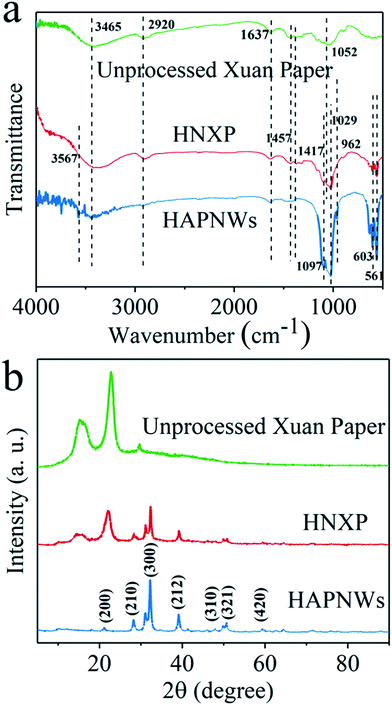 | ||
| Fig. 3 FTIR spectra (a) and XRD patterns (b) of the HNXP paper with a HAP/cellulose weight ratio of 35%, ultralong HAP nanowires (HAPNWs), and commercial unprocessed Xuan paper. | ||
The XRD patterns of the HNXP paper, HAP nanowires and commercial unprocessed Xuan paper are shown in Fig. 3b. The diffraction peaks at 2θ = 21.8°, 28.9°, 32.9°, 39.8°, 48.6°, 50.4° and 59.9° are assigned to the (200), (210), (300), (310), (320), (321), and (420) crystal planes of hydroxyapatite (JCPDS no. 09-0432), respectively. The commercial Xuan paper shows broad diffraction peaks at around 15° and 22.5°. Compared with the pure HAP nanowires, the HNXP paper has obvious broad diffraction peaks at around 15° and 22.5°, which is due to the presence of plant fibers, and has the same hydroxyapatite characteristic peaks. These experimental results indicate that the HNXP paper is composed of HAP nanowires and plant fibers.
Ink wetting mechanism of the HNXP paper
The ink wetting of the paper is a complex phenomenon that involves interactions among the paper, water, and ink constituents. The surface hydrophilic/hydrophobic property has a significant effect on the ink wetting performance of the paper. The traditional Xuan paper is composed of micrometer-sized plant fibers with a porous structure. The commercial unprocessed Xuan paper is hydrophilic both to water and ink. The commercial processed Xuan paper is produced by coating gelatin and alum on the surface of the unprocessed Xuan paper, which can reduce the surface energy of the paper, and it is hydrophobic both to water and ink at the same time.The different ink wetting performances of different kinds of paper are shown in Fig. 4. The thick ink spreads quickly on the commercial unprocessed Xuan paper (Fig. 4a), and the ink particles are absorbed while the ink diffuses. The ink spreading is generally round, with some burrs and small gaps on the edges. However, the ink droplet on the commercial processed Xuan paper is spherical with little penetration, and the stroke edges are relatively smooth (Fig. 4b). Similarly, the shapes “+” and “#” on the commercial unprocessed Xuan paper are relatively obscure, and the patterns on the commercial processed Xuan paper are thin and clear, in contrast, the ink wetting on the HNXP paper is unique and unlike any commercial Xuan paper (Fig. 4c). The edges of the ink droplets are fine, and do not penetrate completely into the back of the paper. The light ink can better reflect this difference. The water in the light ink wets the paper while the ink remains on the paper surface. This is more conspicuous on the pure HAP nanowire paper (Fig. 4d).
The following points are the main factors of the excellent ink wetting property of the traditional Xuan paper. First, the bark fibers of pteroceltis tatarinowii are uniform and slender, the cell cavities are thin and the surface area is relatively large, so the swelling effect of the adsorbed ink is strong. When the paper is inked, the fibers are laterally retained with pen marks and ink particles, and the longitudinally guided ink diffuses laterally along the wrinkles.32 Calcium carbonate (CaCO3) particles accumulated in the wrinkles on the cell wall of the bast fibers also have an influence on the ink wetting performance of Xuan paper,33 which can improve the absorption ability of ink and water.23 In addition, the ink wetting performance of the commercial Xuan paper is closely related to its hydrophilic and hydrophobic properties. The commercial unprocessed Xuan paper has a water contact angle of 0° and an ink contact angle of 0° (Fig. 4e). The diffusion of water and ink particles on the commercial unprocessed Xuan paper is synchronous. The commercial processed Xuan paper is hydrophobic with a water contact angle of 85.22° and an ink contact angle of 87.12° (Fig. 4f). In contrast, the as-prepared HNXP paper with a HAP/cellulose weight ratio of 35% is superhydrophilic with a water contact angle of 0° but an ink contact angle of 55.58° (Fig. 4g), indicating that the diffusion of water and ink components in the ink on the HNXP paper is not synchronized, and the diffusion rate of water in the ink is faster than that of ink particles.
Fig. 5 shows the contact angles of the HNXP paper sheets with various weight ratios of ultralong HAP nanowires ranging from 10% to 100%. One can see that the water contact angles of the HNXP paper sheets with various weight ratios of ultralong HAP nanowires ranging from 10% to 100% are all zero, indicating that the HNXP paper sheets with different weight ratios of ultralong HAP nanowires are superhydrophilic. However, the ink contact angles of the HNXP paper sheets with various weight ratios of ultralong HAP nanowires are very different, and the ink contact angle of the HNXP paper increases with increasing weight ratio of ultralong HAP nanowires. The ink contact angle of the HNXP paper can be well controlled by adjusting the weight ratio of ultralong HAP nanowires. For example, the ink contact angle of the HNXP paper is 33.85°, 43.4°, 50.0°, 55.58°, 68.1°, and 82.2° for a HAP/cellulose weight ratio of 10%, 20%, 30%, 35%, 40% and 100%, respectively. The experimental results demonstrate the unique ink wetting behavior which is absent in the traditional Xuan paper.
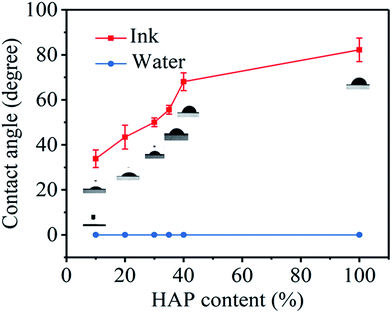 | ||
| Fig. 5 Water contact angle and ink contact angle of the HNXP paper versus the HAP/cellulose weight ratio. | ||
Fig. 6 shows the pore size distribution curves of the as-prepared HNXP paper with a HAP/cellulose weight ratio of 35% in comparison with the paper composed of only ultralong HAP nanowires and commercial Xuan paper. The description of the unique ink wetting performance at the microscale level of the HNXP paper is discussed below. Ultralong HAP nanowires in the HNXP paper are distributed between the pores of plant fibers or wrapped around them, leading to a larger porosity (80.2%) and smaller most probable pore diameter (1.66 μm) (Fig. 6a). The paper composed of only ultralong HAP nanowires has a porosity of 85.6% and a most probable pore diameter of 1.21 μm (Fig. 6b), indicating that the addition of ultralong HAP nanowires can adjust the porosity of the HNXP paper. The unique microstructure and pore diameter of the HNXP paper leads to its unique ink wetting performance.
The most probable pore diameter of the commercial unprocessed Xuan paper is 14.29 μm and the porosity is 75.5% (Fig. 6c). The gelatin and alum particles applied on the commercial processed Xuan paper can block the pores of the fibers on the surface of the paper. Therefore, the porosity of the commercial processed Xuan paper is only 66.4% (Fig. 6d), which is smaller than that of the commercial unprocessed Xuan paper. SEM images show significant difference in the microstructure between the commercial Xuan paper and the HNXP paper. Most particles of the Chinese ink have sizes ranging from 10 to 800 nm (Fig. S1 in the ESI†). When the ink is dripped on the commercial unprocessed Xuan paper, the ink particles in the ink can spread quickly in the pores of the unprocessed Xuan paper with the obvious wetting of water. However, when the ink is dripped on the HNXP paper, the water molecules in the ink quickly spread in the HNXP paper, but the ink particles are trapped by the smaller pores of the HNXP paper, and most ink particles remain on the surface of the HNXP paper.
Durability
Durability of the paper refers to the ability to resist the erosion of natural conditions (such as light, heat, moisture, microbes) on its properties (such as tensile strength, whiteness, etc.).34,35 If the performance of the paper is not significantly reduced during a long period of time, it indicates that the paper has a long lifetime and good durability; otherwise, it has a poor durability.The stability of whiteness and tensile strength are two important factors for the durability of Xuan paper.19 Fig. 7 shows the evaluation of the whiteness stability and durability of the as-prepared HNXP paper with a HAP/cellulose weight ratio of 35% by the accelerated heat aging method for up to 1500 years in comparison with the commercial Xuan paper. Fig. 7a shows the whiteness stability performance of the HNXP paper and commercial Xuan paper measured by the accelerated heat aging method for up to 1500 years. The whiteness of the as-prepared HNXP paper is as high as 80.7%, which is much higher than those of the commercial Xuan paper (the unprocessed Xuan paper is 71.6%, processed Xuan paper is 70.9%). The whiteness of the three kinds of paper gradually decreases with increasing simulated aging time, but the whiteness of the HNXP paper is always higher than those of the commercial unprocessed and processed Xuan paper. Additionally, the whiteness of the commercial processed Xuan paper is always lower than that of the commercial unprocessed Xuan paper. After the accelerated heat aging for 1500 years, the whiteness of the HNXP paper, commercial unprocessed Xuan paper, and commercial processed Xuan paper is 70.7%, 53.9% and 51.0%, respectively. Fig. 7c shows digital images of the three kinds of paper with increasing simulated aging time up to 1500 years, which can more intuitively reflect the process of gradual yellowing of the commercial Xuan paper during the aging process, while the HNXP paper can well maintain its high whiteness. The experimental results indicate that the commercial processed Xuan paper is more likely to become yellow.
Fig. 7b shows the tensile strength change of the HNXP paper and commercial Xuan paper by the accelerated heat aging method for up to 1500 years. The tensile strength of three kinds of paper decreases with increasing simulated aging time, and the tensile strengths of three kinds of paper are close to each other after simulated aging for 1500 years. The original tensile strength of the commercial processed Xuan paper and HNXP paper is similar (HNXP paper is 19.83 N, processed Xuan paper is 21.55 N), and the tensile strength of the commercial unprocessed Xuan paper is 26.14 N. The grammage of the commercial processed Xuan paper, unprocessed Xuan paper and the HNXP paper is 34.3, 32.3, and 37.6 g m−2, respectively. The decomposition of alum on the surface of the commercial processed Xuan paper makes it less robust than the commercial unprocessed Xuan paper.
4. Conclusions
In this work, we have developed a new kind of nanocomposite Xuan (HNXP) paper comprising ultralong hydroxyapatite nanowires and plant cellulose fibers with unique ink wetting performance, high whiteness and excellent durability. The as-prepared HNXP paper has many advantages such as high whiteness, unique ink wetting mechanism, and thousands of years' ultralong durability. The whiteness (81%) of the HNXP paper with a HAP/cellulose weight ratio of 35% is much higher than those of both commercial unprocessed and processed Xuan paper, and it can maintain a high whiteness of 70.7% after the accelerated heat aging for up to 1500 years. The as-prepared HNXP paper has unique ink wetting performance because of its nanoscale porous structure and hydroxy groups of ultralong HAP nanowires, which makes it superhydrophilic while having an ink-resisting property, which is similar to the commercial processed Xuan paper to some extent. The as-prepared HNXP paper sheets with various weight ratios of ultralong HAP nanowires ranging from 10% to 100% are all superhydrophilic with a water contact angle of zero. In contrast, the ink contact angle of the HNXP paper can be well controlled by adjusting the weight ratio of ultralong HAP nanowires, and the ink contact angle of the HNXP paper increases with increasing weight ratio of ultralong HAP nanowires, demonstrating unique ink wetting performance of the as-prepared HNXP paper, which is absent in the traditional Xuan paper. The new kind of nanocomposite Xuan paper developed in this work is promising for the application in calligraphy and painting arts.Conflicts of interest
There are no conflicts to declare.Acknowledgements
Financial support from the National Natural Science Foundation of China (21875277, 51702342), and Industrialization Innovation Project of Shanghai Institute of Ceramics, Chinese Academy of Sciences (Y71ZCC1C0G) is gratefully acknowledged.References
- T. S. Cao, J. Hefei Normal Univ., 2012, vol. 30, pp. 45–56 Search PubMed.
- R. Q. Liu, Encyclopedic Knowledge, 2010, vol. 2, pp. 24–27 Search PubMed.
- K. Xu, J. L. Wang and Q. J. He, Spectrosc. Spectral Anal., 2018, 38, 1829–1833 CAS.
- W. J. Xu, Sci. Conservation Archaeology, 2008, vol. 4, pp. 47–50 Search PubMed.
- Y. Tang and G. J. Smith, J. Cult. Herit., 2013, 14, 464–470 CrossRef.
- F. F. Chen, Y. J. Zhu, Z. C. Xiong, T. W. Sun and Y. Q. Shen, ACS Appl. Mater. Interfaces, 2016, 8, 34715–34724 CrossRef CAS PubMed.
- N. L. D'Elía, C. Mathieu, C. Hoemann, J. A. Laiuppa, G. E. Santillán and P. V. Messina, Nanoscale, 2015, 7, 18751–18762 RSC.
- C. Li, A. K. Born, T. Schweizer, M. Z. Wong, M. Cerruti and R. Mezzenga, Adv. Mater., 2014, 26, 3207–3212 CrossRef CAS PubMed.
- P. Das and N. R. Jana, ACS Appl. Mater. Interfaces, 2016, 8, 8710–8720 CrossRef CAS PubMed.
- D. Li, J. He, X. Huang, J. Li, H. Tian and X. Chen, RSC Adv., 2015, 5, 30920–30928 RSC.
- L. C. Palmer, C. J. Newcomb, S. R. Kaltz, E. D. Spoerke and S. I. Stupp, Chem. Rev., 2010, 40, 4754–4783 Search PubMed.
- H. H. Liu, H. J. Peng, Y. Z. Cai, C. Zhang and G. W. Xu, Biomaterials, 2013, 34, 4404–4417 CrossRef CAS PubMed.
- Q. Wang, W. Huang, D. Wang, B. W. Darvell, D. E. Day and M. N. Rahaman, J. Mater. Sci.: Mater. Med., 2006, 17, 641–646 CrossRef CAS PubMed.
- Y. Wan, C. Wu, G. Zuo, G. Xiong, J. Jin and R. Guo, Mater. Chem. Phys., 2015, 156, 238–246 CrossRef CAS.
- B. Q. Lu, Y. J. Zhu and F. Chen, Chem.–Eur. J., 2014, 20, 1242–1246 CrossRef CAS PubMed.
- Y. G. Zhang, Y. J. Zhu and F. Chen, Mater. Lett., 2017, 144, 135–137 CrossRef.
- Y. Y. Jiang, Y. J. Zhu, F. Chen and J. Wu, Ceram. Int., 2015, 41, 6098–6102 CrossRef CAS.
- H. Li, S. T. Guo, L. B. Wang, J. Wu, Y. J. Zhu and X. L. Hu, Adv. Energy Mater. DOI:10.1002/aenm.201902497.
- L. Y. Dong and Y. J. Zhu, ACS Sustainable Chem. Eng., 2018, 6, 17239–17251 CrossRef CAS.
- L. Y. Dong and Y. J. Zhu, Chem.–Eur. J., 2017, 23, 4597–4604 CrossRef CAS PubMed.
- H. Li, Y. J. Zhu, F. Chen, Y. Y. Jiang and Y. D. Yu, ChemNanoMat, 2017, 3, 259–268 CrossRef CAS.
- J. Li, L. Xu and Y. Y. Fang, Sci. Res., 2016, 20, 283–284 Search PubMed.
- D. S. Zhao, X. B. Liu and C. Q. Yin, China Pulp Pap. Ind., 2014, 14, 36–39 Search PubMed.
- Y. Tang, G. J. Smith, R. J. Weston and X. Kong, J. Cult. Herit., 2017, 28, 82–89 CrossRef.
- R. Q. Liu, Paper and Paper Making, 2018, vol. 27, pp. 76–79 Search PubMed.
- W. J. Xu and Y. S. Chen, Sci. Conservation Archaeology, 2005, vol. 2, pp. 27–30 Search PubMed.
- Y. W. Li, W. Tong, X. Sun, W. P. Zhou and L. L. Gao, China Pulp Pap., 2018, 37, 36–42 Search PubMed.
- M. G. Ma and J. F. Zhu, Eur. J. Inorg. Chem., 2009, 36, 5522–5526 Search PubMed.
- M. R. Gandh, G. N. Kousalya and S. Meenakshi, Int. J. Biol. Macromol., 2011, 48, 119–124 CrossRef PubMed.
- R. Murugan and S. Ramakrishna, Biomaterials, 2004, 25, 3829–3835 CrossRef CAS PubMed.
- I. Rehman and W. Bonfield, J. Mater. Sci.: Mater. Med., 1997, 8, 1–4 CrossRef CAS PubMed.
- S. Y. Wu, X. L. Wu and P. K. Chu, J. Mater. Sci. Technol., 2016, 32, 182–188 CrossRef.
- S. Zheng, M. Du, W. N. Miao, D. Y. Wan, Z. P. Zhu, Y. Tian and L. Jiang, Adv. Funct. Mater., 2018, 28, 1800832 CrossRef.
- J. R. Martínez, A. Nieto-Villena, J. Á. de la Cruz-Mendoza, G. Ortega-Zarzosa and A. L. Guerrero, J. Cult. Herit., 2017, 26, 22–27 CrossRef.
- A. Kupczak, A. Sadłowska-Sałęga, L. Krzemień, J. Sobczyk, J. Radoń and R. Kozłowski, Energy Build., 2018, 158, 77–85 CrossRef.
Footnote |
| † Electronic supplementary information (ESI) available. See DOI: 10.1039/c9ra08349a |
| This journal is © The Royal Society of Chemistry 2019 |

